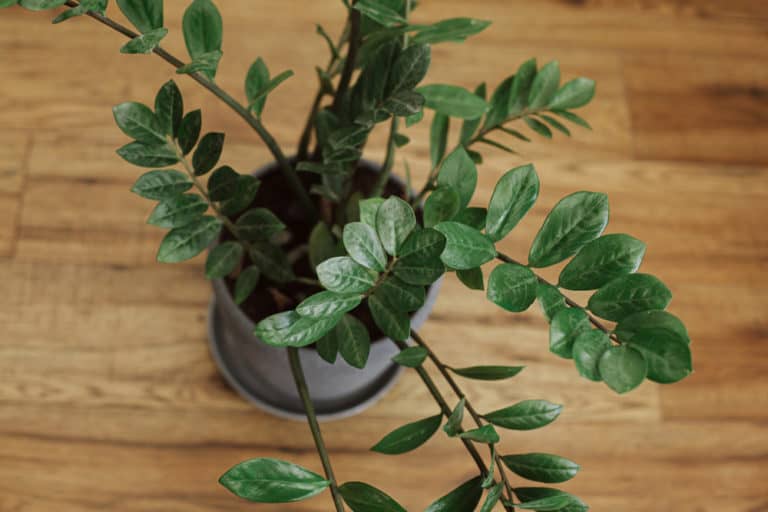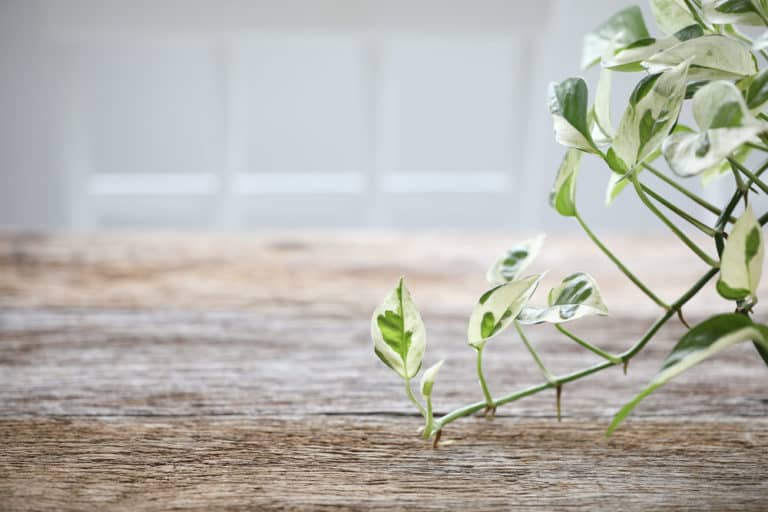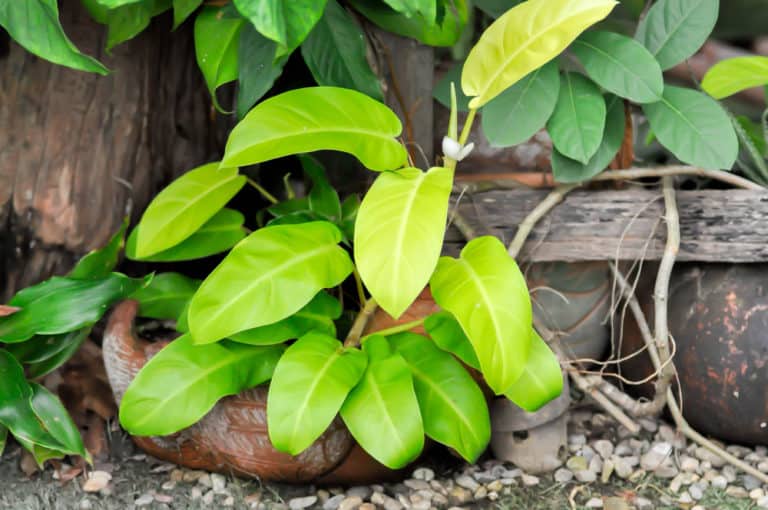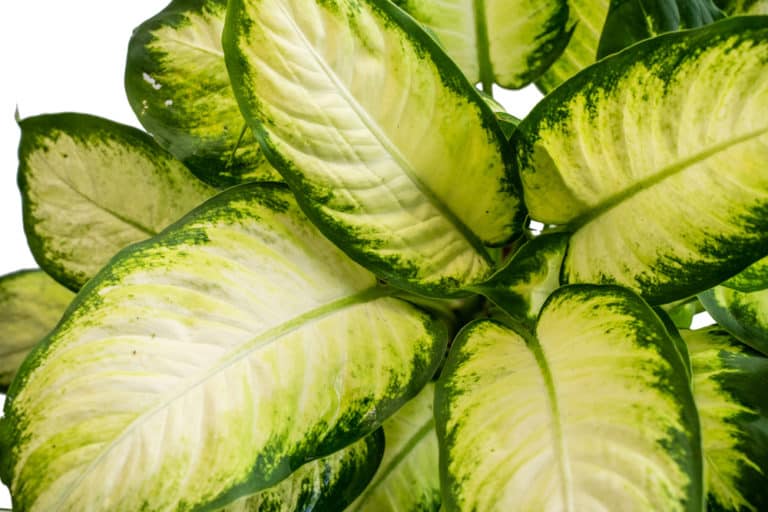Calathea Lietzei ‘White Fusion’ Care Guide (2024)

Calathea White Fusion is a stunning new cultivar that was first discovered in 2007.
While it can be demanding in terms of growing conditions, the dramatic variegation of the Calathea lietzei foliage has made it a very popular houseplant.
Give your Calathea White Fusion a warm spot out of the direct sun and keep it moist to enjoy its beautiful foliage for years.
| Scientific Name | Calathea lietzei ‘Fusion White’ |
| Common Name | Calathea White Fusion, Peacock Plant |
| Light | Bright indirect sunlight |
| Watering | Weekly, water if the top inch of soil is dry |
| Temperature | 60°F to 80°F (15 to 26ºC) |
| Hardiness Zone | 11b-12b |
| Humidity | 75-85% |
| Soil Type | quick-draining |
| Soil pH | 6.5 (mildly acidic) |
| Fertilizing | A balanced feed once a month in spring and summer |
| Repotting | Every 1-2 years |
| Pruning | As needed to remove dead leaves |
| Propagation | Root in water or soil or divide roots |
| Toxicity | Not toxic to humans and pets |
| Mature Size | 12 to 24 inches as a houseplant |
| Bloom Time | Rarely flowers |
What’s Unique About Calathea White Fusion?
Calathea White Fusion plants have absolutely stunning foliage.
The beautifully variegated leaves almost looked like a watercolor painting with gentle gradations of color from bright green to pure white.
The underside of the leaves is dark maroon for an added dash of color.
The Calathea family of plants are native to the rainforests of South and Central America, and have that tropical feel perfect for an indoor garden.
Even better, unlike so many tropical houseplants, your Calathea White Fusion plant is perfectly safe for pets and children.
While growing Calathea White Fusion may be a bit challenging, the beauty of the foliage is well worth the effort.
Calathea White Fusion Care
Calathea White Fusion plant care can be a bit tricky.
However, as long as you provide it with growing conditions similar to the rainforests where this tropical native originates, you should be able to keep it thriving.
Calathea lietzei care is all about keeping it warm, with moist soil and high humidity, and out of direct sun.
Light
In the tropical rainforest, Calatheas grow under the tree canopy, and so Calathea lietzei light needs are for bright but indirect sunlight.
In your home, you can easily accommodate Calathea White Fusion light requirements without using special grow lights.
In a north or east-facing room, you can place your Calathea White Fusion planter next to a window. However, in a south or west-facing room, you need to keep them out of the full sun, which can burn the leaves and stress the plant.
Placing a sheer curtain between the Calathea White Fusion and the window can do a lot to protect it from the direct sun.
Watering
In the tropical rainforest, rainfall is frequent but the soil drains quickly, so Calathea White Fusion watering needs are for consistently moist soil that is not soggy.
Calathea White Fusion watering should be done every 5-10 days, but rather than keep to a regular schedule, only water when the top inch of the soil has dried out.
When you water Calathea lietzei, use distilled or rain water, as Calathea White Fusion is very sensitive to fluoride, which is usually added to tap water.
If you must use tap water, let it sit in an open container overnight to let the fluoride dissipate.
Temperature
The ideal temperature for Calathea lietzei is on the high side, as you would expect from a tropical native.
The Calathea White Fusion temperature range is 60°F to 80°F (15 to 26ºC). You should be able to provide this without any supplemental heating.
Keep your Calathea White Fusion away from air conditioning vents and fans, as the cooler air can damage the foliage.
Even in temperate climates you can move your Calathea White Fusion outdoors in hot summer weather, as long as you find a shady spot for it..
Calathea White Fusion has little temperature tolerance below that range. Temperatures below 50°F (10ºC) can damage the plant, and it has no frost hardiness whatsoever.
Humidity
The ideal humidity for Calathea lietzei is high, at around 75-85%.
This is a challenging humidity level in an indoor environment, as most homes are best at about 30% or so.
To meet your Calathea White Fusion humidity requirements, you need to create a localized spot with high humidity. You may have other tropical plants that also need moist conditions, so group them together.
You can invest in a small humidifier to raise the humidity level in their immediate vicinity, or place them on a pebbled tray filled with water.
Alternatively, you can mist the foliage with a fine mist several times a week. Use distilled water to avoid mineral build-up on the leaves.
Soil
Calathea White Fusion soil needs to be able to retain moisture while at the same time letting excess water drain out. Imagine a damp sponge rather than one that is dripping wet.
Soil that stays too wet will lead to rot rot and other problems.
The best pH level for Calathea lietzei is around 6.5, or slightly acid.
African Violet soil mix is readily available in most garden centers and is a good soil for Calathea lietzei. It will stay moist but also is well-draining.
You can also make your own custom mix for your Calathea White Fusion by combining equal parts of perlite, bark, and potting soil.
Fertilizer
Calathea White Fusion needs nutrients to support the optimum growth of its lush foliage.
Aim for a balanced fertilizer ratio of 10-10-10 or 5-5-5 for your Calathea White Fusion fertilizer.
You can use a liquid fertilizer for Calathea lietzei, applied once a month in spring and summer, but dilute it to half the recommended strength for best results.
If you prefer to not have to feed once a month, you can add slow-release granules to the soil, which should last for the entire growing season.
Alternatively, when you pot your Calathea White Fusion, use a generous amount of compost in your soil mix, and that should last until you repot.
Potting & Repotting
Calathea White Fusion repotting should be done every year or two.
You’ll know when it’s time for repotting Calathea lietzei when leaves start drooping and roots are growing out the drainage holes.
When the plant becomes rootbound there isn’t enough soil left to hold the moisture the plant needs, so it’s time to increase the pot size.
Using a plastic pot when potting a Calathea White Fusion can be helpful to help the soil conserve moisture, but make sure that the pot has good drainage holes.
Use fresh potting mix and water the plant well before and after you repot.
Pruning
You do not need to do much Calathea White Fusion pruning.
Because Calathea White Fusion naturally grows into an attractive bushy shape, you will not need to trim it to form.
However, you will find yourself cutting Calathea lietzei leaves that are dead or damaged. Not only will this keep it looking its best, but you want to discourage the development of disease.
Using a sharp, sterilized knife or pair of scissors, cut off the leaf where it joins the stem. Fresh new growth will follow.
Do not leave the trimmings on the soil surface. Dispose of them in the garbage or compost.
Propagation
Calathea White Fusion propagation is a great way to create additional plants to keep, sell, or give away.
The easiest way to propagate Calathea lietzei is by dividing your original plant when repotting. Gently tug apart the new clumps forming on the outer part of the root ball and plant out in separate pots.
If you are not ready to repot, you can take stem cuttings. Using a sharp, sterilized knife, cut a stem an inch below a leaf node.
Stick the cuttings into a soil medium or a glass of water with the leaf node below the surface.
In about a month you should see new roots forming. Plant out each new baby plant in a 3 inch pot and water it well.
Also, make sure to check out our in-depth Calathea white star plant care guide.
Common Problems of Calathea White Fusion
You may encounter some Calathea White Fusion problems while growing these beauties.
However, catching problems with Calathea lietzei early can help you save your plant.
Keep a close eye on the leaves of Calathea White Fusion to identify signs of insect damage and disease so that you can identify the culprit and solve the problem.
Pests
The lush leaves of Calathea White Fusion are an inviting environment for bugs.
Early identification of Calathea White Fusion pests can help you deal with the infestations and keep your Calathea lietzei healthy.
Fungus gnats love the moist conditions in which Calathea White Fusion thrives. If you see small black flies, you can deter them by using neem oil on the leaves.
Spider mites leave small yellow or white spots on the leaves, and in severe infestations spin their sticky webs. They can be removed by showering the entire plant with tepid water. Neem oil should discourage them from returning.
Aphids are light green bugs on the underside of leaves. Spray the entire plant with insecticidal soap.
Diseases
The high moisture levels that Calathea lietzei loves create conditions in which diseases can flourish.
It’s important to watch out for signs of Calathea White Fusion diseases so that you can treat them before they kill your plant and spread to others.
Pseudomonas leaf spot can be identified by white splotches on the leaves. Unfortunately, there is no way to cure this bacterial disease, so you must destroy the plant to protect the rest of your houseplants.
If your Calathea White Fusion develops yellowing leaves and mushy stems, you probably have root rot. Remove the plant from its pot and cut away all black roots, also trimming off all affected leaves and stems. Replant in fresh potting, well-draining soil and make sure it is never in standing water.
Growing Problems
Not all growing problems with Calathea White Fusion are caused by disease or pests.
Sometimes when you seem to have a sick plant you just need to tweak its growing conditions to restore it to beautiful health.
If the leaves of your Calathea White Fusion are turning brown, you may be overwatering the plant. Only water when the surface of the soil is dry.
Brown or all-green leaves may also indicate that your Calathea White Fusion is getting too much light. Move it to a shadier spot away from the full sun or screen the sunlight with a sheer curtain.
Toxicity of Calathea White Fusion
One of the advantages of growing Calathea lietzei as a houseplant is that it is not toxic to humans or other mammals. However, it is poisonous to fish and birds.
Because of this lack of toxicity, you have more options in where to place your Calathea White Fusion planters.
This makes it a good alternative to pothos plants when safety of children and pets is a concern.
For Humans
While many tropical plants are dangerous when ingested, Calathea White Fusion is not toxic to humans.
This makes it a safe plant to use in a home where children live or visit, since they sometimes get curious and nibble on an inviting leaf.
However, the plant tissue does contain saponin compounds which can irritate the skin. If you have sensitive skin, it’s a good idea to wear gloves when tending your Calathea White Fusion to avoid direct contact with the leaves or stems, especially if you are cutting them.
If you have an allergic reaction, rinse the affected area thoroughly and use a topical cream if necessary.
For Pets
Calathea White Fusion is not toxic to common pets. Cats and dogs cannot be poisoned by this houseplant.
If a cat does eat too much Calathea White Fusion foliage, they may get an upset stomach, but that’s the worst to be expected.
Calathea White Fusion is more in danger from cats than the reverse, as some cats can rip a plant apart. It’s a good idea to keep this expensive plant out of reach of sharp claws and teeth.
However, it is highly toxic to fish and birds. Luckily the chances of them being exposed to Calathea White Fusion is low.
Calathea White Fusion Appearance
The Calathea White Fusion appearance is dramatic. Its extravagantly variegated leaves create a beautiful show, and the compact growth of this bushy plant makes it a perfect tabletop decoration.
While your Calathea White Fusion is unlikely to bloom as an indoors plant, you will be more than satisfied with its colorful foliage.
Foliage
The foliage of Calathea White Fusion is definitely its main attraction for plant-lovers.
Each leaf has broad strokes of white and green blending into each other. On the underside they are a deep maroon, adding another dimension of color which continues down into the stems which hold the leaves erect.
The leaves grow to a mature size of around 6 inches long and half that across.
They are extremely thin and delicate, which allows light to shine through them, but they also must be handled carefully to avoid damage. You should gently wipe them down once a month to remove any dust that has accumulated.
Flowering
It is very unlikely that you will see a Calathea lietzei flower.
Calathea White Fusion flowering is extremely rare, especially when it is grown as a potted plant indoors, as is the case in temperate climates.
Blooming may occur when it reaches full maturity under absolutely ideal conditions of temperature, humidity, and watering, along with regular fertilization.
When they do appear, the flowers of Calathea White Fusion are unremarkable with no scent.
Instead of trying to make your Calathea White Fusion bloom, focus instead on the spectacular variegated leaves which will more than make up for the lack of flowers.
Size and Growth
Calathea White Fusion has a moderately fast growth rate and remains a manageable size without any pruning.
The full size of Calathea White Fusion is around 24 inches tall and 18 inches wide.
You can expect it to reach its mature size within a year and stay that way indefinitely.
Repotting will not increase its size but will keep it from becoming root bound as you split off small plants that develop around the original plant.
It does not need to be staked to remain upright as it grows. The leaves arch out from their stems in a naturally graceful form.
Calathea White Fusion Fragrance
There is no Calathea White Fusion fragrance.
The foliage has no scent, and the rare flowers are fragrance-free as well.
For people with a sensitivity to fragrances, Calathea White Fusion is a good choice for including in their indoor garden. In public spaces such as medical clinics or nursing homes this is also a desirable quality.
Instead, you can appreciate the dramatically variegated leaves which add a tropical feel to any space.
Since there are many other potted plants such as camellias or geraniums that do have a strong, pleasant scent, consider including them as well if fragrance is an important component of growing plants for you.
Suggested Uses for Calathea White Fusion
The compact size and stunning appearance of Calathea White Fusion lends itself to a variety of locations in your home.
Because of its attractive foliage, you may choose to place it as a stand-alone design element on a table or ledge by itself where it can be fully appreciated.
It will grow happily in the humid environment of a bathroom. If there’s no natural light in there you may need to move it out to a brighter spot from time to time to keep its colorful foliage at its best.
While it’s usually grown indoors, you can move it out to a shady patio for the hot summer months.
FAQ
What is Calathea White Fusion?
Calathea White Fusion is a bushy, evergreen tropical plant native to Central and South America rainforests. It has variegated foliage and is grown as a houseplant.
How to identify Calathea White Fusion?
Calathea White Fusion has lanceolate leaves arching out on thick stems. They have variegated colors ranging from pure white to bright green with dark purple undersides.
How to care for Calathea White Fusion?
Calathea White Fusion should be grown in warm temperatures with high humidity and kept out of direct sun. The soil should be kept moist but not wet.
How to grow Calathea White Fusion indoors?
Keep Calathea White Fusion out of full sun in a warm spot. Maintain high humidity with a pebble tray, humidifier, or by misting the leaves regularly.
How to grow Calathea White Fusion outdoors?
Calathea White Fusion can be grown outdoors year-round in tropical climate zones. In temperate climates potted plants can be moved out to a shady spot in summer.
How fast does Calathea White Fusion grow?
Calathea White Fusion is a perennial evergreen tropical plant that will reach its full size within a year, and then remain at that height indefinitely.
How tall does Calathea White Fusion grow?
Calathea White Fusion can reach a full size of 24 inches tall and 18 inches wide. It then puts its growing energy into producing offshoots that can be divided.
How to make Calathea White Fusion grow faster?
To encourage the fastest Calathea White Fusion growth, provide it with warm temperatures, high humidity, moist soil and regular fertilization in a bright spot out of the full sun.
How to stake Calathea White Fusion?
Calathea White Fusion does not require staking to grow upright. It is not a vining plant and does not naturally train itself up a support.
How to pot Calathea White Fusion?
Plant your Calathea White Fusion in a pot with good drainage holes, using a soil mix which will hold water but not be sopping wet.
How to revive Calathea White Fusion?
If your Calathea White Fusion is drooping, it probably needs watering. If it is dry, water the soil surface several times until water runs out the drainage holes.
Why is my Calathea White Fusion dying?
Your Calathea White Fusion may have a bacterial or fungal disease. If the roots are turning black, cut out the affected parts and replant in fresh soil.
Why is my Calathea White Fusion drooping?
If the soil is dry, it needs watering. If it is in too bright a location, move it out of the full sun. If it is becoming rootbound, divide it and repot.
How cold can Calathea White Fusion tolerate?
Calathea White Fusion will not grow well below 50°F (10°C), so keep it away from air conditioning vents and drafts. It has no frost tolerance at all.
How to get rid of pests on Calathea White Fusion?
Identify the insects attacking your Calathea White Fusion, and use neem oil or insecticidal soap applied all over the plants to eliminate them and prevent further infestations.
Is Calathea White Fusion toxic to cats?
No, Calathea White Fusion is not toxic to cats, although it is possible a cat may get an upset stomach if it ingests very large quantities.
Is Calathea White Fusion toxic to dogs?
No, Calathea White Fusion is not toxic to dogs at all. They will not suffer any adverse reaction if they ingest any part of the plant.
Is Calathea White Fusion toxic to children?
No, Calathea White Fusion is not toxic to children. This makes it a safe plant to use anywhere in your home without worrying about possible adverse effects.
Is Calathea White Fusion toxic to humans?
No, Calathea White Fusion is not toxic to humans. The only possible side-effect from exposure is a mild skin irritation which can be treated with topical creams.
Does Calathea White Fusion have a scent?
Calathea White Fusion’s foliage has no scent, and even its rare flowers are reported to be scentless as well. This makes it a good choice in fragrance-free settings.






